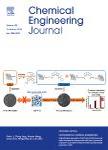版权所有:内蒙古大学图书馆 技术提供:维普资讯• 智图
内蒙古自治区呼和浩特市赛罕区大学西街235号 邮编: 010021

作者机构:Nanjing Agr Univ Coll Resources & Environm Sci Inst Organ Contaminant Control & Soil Remediat Nanjing 210095 Jiangsu Peoples R China Univ Maria Sklodowska Curie Dept Environm Chem PL-20031 Lublin Poland
出 版 物:《CHEMICAL ENGINEERING JOURNAL》 (化学工程杂志)
年 卷 期:2019年第364卷
页 面:79-88页
核心收录:
学科分类:0830[工学-环境科学与工程(可授工学、理学、农学学位)] 0817[工学-化学工程与技术] 08[工学]
基 金:National Key R&D Plan Key Projects, China [2016YFD0800203] National Natural Science Foundation of China [41877125, 41771523] Jiangsu Provincial Key Research and Development Plan, China [BE2017718]
主 题:Vanadium oxide Persulfate Activator Polycyclic aromatic hydrocarbons Oxidation degradation
摘 要:A novel investigation into the utilization of vanadium oxide (V2O3) as a persulfate (PS) activator in phenanthrene degradation in an aqueous system, and its subsequent pathway, was undertaken. The V2O3/PS has a high thermal degradation activity for phenanthrene at either room temperature (25 degrees C) or higher (35 degrees C and 45 degrees C), with a better performance (up to five times reuse) and a shorter degradation time. Phenanthrene can be effectively degraded under different pH conditions (pH 3, 5, 7, and 9), with a low PS concentration (2 mmol/L), activated by a small V2O3 loading (0.1 g/L). The electron paramagnetic resonance (EPR) technique combined with 5,5-dimethyl-1-pyrroline N-oxide (DMPO, 0.1 mol/L), captured sulfate (SO4 center dot-) and hydroxyl ((OH)-O-center dot) radical signals in the V2O3/PS system, generated from PS activation with V2O3. Free radical quenching studies revealed that both SO4 center dot- and (OH)-O-center dot contributed to phenanthrene degradation. The PS activation mechanism by V2O3 was elucidated. V2O3-activated PS produced SO4 center dot- and VO2 via electron transfer, with VO2 transferring a further electron to activate PS for SO4 center dot- and V2O5 generation, and a portion of the produced SO4 center dot- converted to (OH)-O-center dot. V2O3-activated PS generated four ion oxidation products (VO2, V2O5, V (V) and V (IV)), whereby VO2 and V2O5 actively participated in phenanthrene degradation, whereas V (V) and V (IV) provided no effective activation. A phenanthrene degradation pathway in the V2O3/PS system was proposed based on the identification of phenanthrene intermediates through liquid chromatography-mass spectrometry. These findings provide valuable insight into PS activation using a unique activator (V2O3) in the removal of environmental organic pollutants.